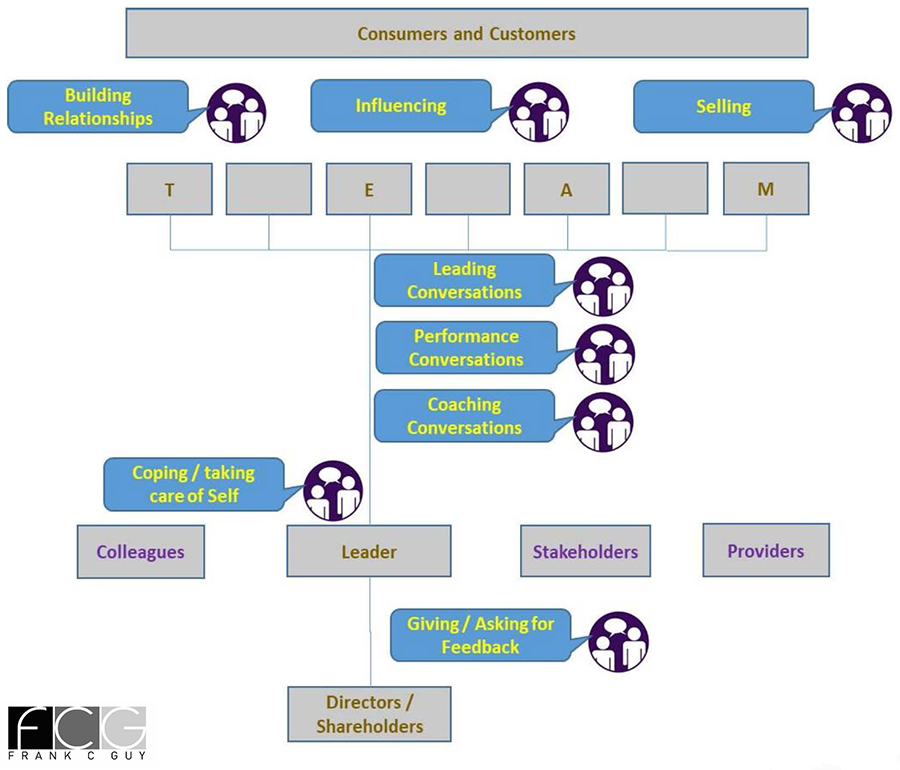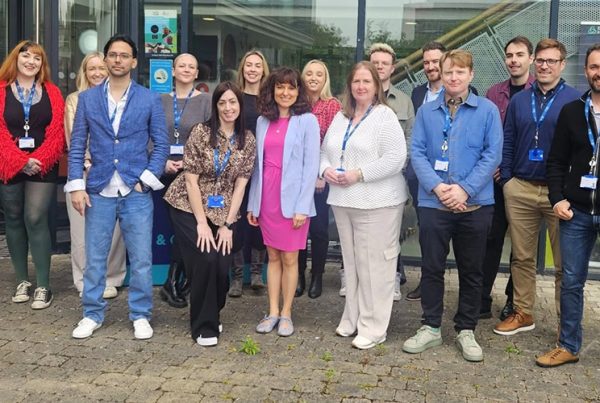
Every blog about being a successful entrepreneur discusses the value of good leadership. But what does it mean to be a good leader? One of the defining characteristics of business visionaries seems to be their ability to build relationships. We spoke to one of the New Frontiers regional trainers, Frank C Guy, a leadership and performance coach with extensive experience in this area. How does he approach this area of leadership and relationships?
Frank sums up his philosophy in the mantra, If you want to improve results, build relationships. If you want to build relationships, improve the conversations. When people on the front-line aren’t doing a good job, it’s often because leadership aren’t giving them the right help or support. In Frank’s view, “This tends to be because communication in business is either not happening or is happening badly. There’s a belief that if you just sit down and have a chat with someone about an issue, it will somehow resolve itself. In reality, for conversations to be truly productive, they much be approached with far more intention and skill.”
Turning organisational structure on its head
One of the first things Frank does when working with startup founders is get them to change their traditional thinking about how an organisation is structured. He advises that we turn the hierarchical pyramid – where the bosses are at the top and the workers are at the bottom – on its head. The chart he uses (below) places the directors and shareholders at the bottom, because it’s their job to support the rest of the organisation. If you look at organisations in this way, you also start to question the language we use about organisations, which is very top-down and directional (phrases like ‘moving up the ladder’, ‘a sideways move’, ‘being demoted down’ are everyday business parlance).

Build relationships, one conversation at a time
Once you start thinking about the leadership role as being one of support, you can see how crucial relationship building is. And at the heart of this lies communication.
As Frank says, “A leader communicating with their team may be having any of three different types of conversation: leading conversations, performance conversations, or coaching conversations. To be effective, leaders need to be aware of what approach they are taking and decide which is best in any given situation. I use the metaphor that a leader wears a different hat depending on what type of conversation they are having.”
What are the main characteristics of these three conversation types?
Leading conversations are about involving people
You may talk about topics such as: Where we are going? What is our purpose? Where do different people fit in? What is a person’s significance? These conversations could happen during one-to-ones or in team meetings. These conversations are how you get people engaged.
Performance conversations are about success
You may talk about topics such as: These are your targets. Are you meeting your goals? Do you need support? Let’s review your KPIs. These conversations are what people managers spend a lot of time on, but they aren’t really leadership conversations.
Coaching conversations are about questioning and listening
These vital conversations are about letting the individuals on your team work things out for themselves. Generally, people have the answers, as long as you give them the means to work out what they need to do. Coaching conversations empower people to bring you solutions rather than problems.
“There is another type of conversation that happens in business but is not a leadership conversation. Feedback. Typically, we neither ask for feedback nor give it because it is so often negative. We’re just not doing it well. But, if you can get feedback right – whether you are trying to improve someone or encourage them – you can use feedback as a tactic for build great relationships.”
Different approaches in conversations
There is a sliding scale for conversations that goes from non-directive at one end to directive at the other. Frank recommends always taking a non-directive approach, if possible. Directive approaches will be necessary in business, of course. There are situations where you have to provide instructions on the correct way to carry out a task or tell someone what you need them to do. But coaching lives at the other, non-directive, end of the scale.
“Coaching conversations are about repeated questioning and listening and reflecting back what you are hearing. If you’re coaching someone, and you think they can work out a problem for themselves, don’t advise them and don’t instruct them. If they don’t manage to arrive at a solution, then you might ask a question along the lines of ‘I wonder what would happen if…’ which is a suggestion they can take as their own and hopefully make a breakthrough with.”
Questioning and listening aren’t skills we are taught, so most of us aren’t particularly good at either. During a conversation, we’re often just waiting for an opportunity to jump in and show off our own brilliance. Steven Covey describes this phenomenon as listening “with the intent to reply, not to understand” in his book 7 Habits of Highly Effective People. Leaders need to train themselves to listen better so they can have more effective conversations.
Advice for questioning and listening during conversations
In a startup business, you will bring people in to work with you who need help and support to deliver what you need. Franck encourages founders to have real conversations with their team on a regular basis, allowing them to work through issues. You may need to have performance conversations with these employees, and that’s fine. But a lot of the time, the non-directive approach is best, helping people to feel empowered and autonomous. This is really important for motivation, which will be key to building a successful business.
There are also lots of conversations that need to happen with people outside the startup. Imagine a scenario where you meet with a potential customer. You’ll probably be tempted to launch into a pitch along the lines of here’s my product/service, this is what it does, and these are the benefits. It’s called the tell-and-sell method. Frank recommends a different approach. Spend more time trying to understand what’s going on with the other person: What do they know? What do they really need? What are their wants? You can use this information to make them a more tailored offer.
“Because we aren’t taught to listen, we tend to interrupt, get distracted, make assumptions, change the topic, or rush people. My advice to founders is to ask the right questions and then consciously listen to the answers. If you’re not sure if you were doing it right, just ask yourself who was doing most of the talking. If it was you, that conversation won’t bring you the best results. This applies to all the conversations you have as a leader, whether with your team, suppliers, investors, etc.
It’s about building relationships and influencing people. When you listen with full attention, people feel understood, then they feel respected. People want respect; when you give them this you are fulfilling a basic human need. It’s a vital element of building trust, which is the ultimate goal.”
Frank’s guidance for questioning
- At the start of a conversation, start questions with What…? and How…? You can also use the alternative opener of Tell me…
- As a conversation progresses and you want to refine your questioning, you might start questions with When…? Where…? Which…? and Who…?
- Don’t start questions with Why…? It’s a very confrontational question that puts people on the defensive and forces them to justify their actions. Imagine being in a meeting and someone asking, “Why are you wearing that shirt?” Ouch! Now imagine the person asks, “How do you decide what to wear in the morning?” This question doesn’t cause the same reaction at all.
- Try to ask questions for which there isn’t a Yes or No answer. Ask open questions that allow people to express themselves fully.
- Keep your questions short and sweet. Some examples are What’s up? What happened? How come? These kinds of question help you to keep the conversation flowing while allowing you to dig further. If your questions are really long, everyone will lose the thread.
Frank’s guidance for listening
- What makes you a good listener is genuine curiosity. If you aren’t truly seeking to learn and understand the other person, your conversations won’t give you real value.
- Focus ALL your attention on the other person. Resist all those reasons to get distracted – both external and internal
- Maintain eye contact (only important for listeners)
- Give the person time to respond and don’t interrupt. Remember the acronym WAIT: Why Am I Talking?
- Bring a conversation to life by looping back or mirroring in three ways:
i) repeat a word or two to show the person you heard what they said;
ii) repeat back in your own words what you’re hearing (a paraphrase); and
iii) summarise what you heard back to them to confirm you have understood correctly. - Don’t take notes! You cannot listen fully and take notes at the same time. Also, looking down to write note means you are no longer maintaining eye contact. If there is something you MUST record, ask for a pause in the conversation so that you can do so.
As you can see, communication skills can help leaders to foster a culture of trust, understanding, and collaboration. The methods Frank describes may not come naturally to everyone, but they can be learned. Effective conversations are a crucial aspect of leadership, and investing time and effort in this area will have an immediate effect on you and those around you.
About the author
 Scarlet Bierman
Scarlet Bierman
Scarlet Bierman is a content consultant, commissioned by Enterprise Ireland to fulfil the role of Editor of the New Frontiers website. She is an expert in designing and executing ethical marketing strategies and passionate about helping businesses to develop a quality online presence.
 Scarlet Bierman
Scarlet Bierman








